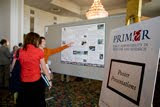
PRIM&R is now accepting abstracts for the 2010 IACUC Conference Poster Presentations. The goal of the annual poster presentations is to provide a platform for members of the IACUC community to share ideas, information, and practical strategies that solve the many challenges faced by IACUC professionals. A poster presentation is your opportunity to showcase your research or innovative projects to stimulate informal discussion among presenters and conference attendees.
Last year, three of the accepted abstracts were selected for both a poster and oral presentation. These abstracts included:
- Meeting Responsibilities: the Institutional Animal User Education and Training Program at the University of Saskatchewan, which was presented by Amanda Plante, UCACS Education and Training Committee, University of Saskatchewan.
This abstract describes the University of Saskatchewan’s newly implemented training program that “consists of an on-line UCACS animal care course, practical skills training, one-on-one training, documenting education and training, [and] monitoring procedures.” The program was so successful that “effective January 1, 2009, approval of an animal use protocol (new or annual review), by the AREB requires (or is conditional upon) successful completion of the UCACS Animal Care Course by all personnel listed on the protocol, including the principal investigator. Any new personnel added to a currently approved protocol must complete the on-line course before beginning any work with animals[…] Currently, the UCACS Education and Training Committee (ETC) is developing a shortened version of the on-line course that can be completed by licensed veterinarians.”
- Random Source (Class B) Dealer Activities: October 31, 2007- November 1, 2008, which was presented by Gary P. Goldberg DVM, DACLAM, USDA/APHIS/Animal Care. This study was implemented in response to an inquiry from the Institute of Laboratory Animal Resources.
“This review included sources of acquisition such as from private individuals, municipal pounds or shelters, and from other licensee or registrants. The disposition of these animals was categorized as to individuals, other licensee/registrants, or to research facilities[…] In order to estimate the teaching use of the random source animals, the records of random source dogs and cats were surveyed for campuses where U.S. Medical Colleges, U.S. Veterinary Colleges, and U.S. Veterinary Technician Schools were located.
- MONiTOR: Monitoring Of Novartis’ in vivo Techniques, Operations, & Research, which was presented by David DeOrnellis, BS, RLATg, CPIA and Colleen Cody, BS, Novartis Institutes for BioMedical Research, Inc.
This abstract describes the “dynamic and comprehensive program for monitoring compliance of NIBR Cambridge in vivo research. MONiTOR is unique due to the incorporation of all aspects of in vivo research in its scope, including the conductance of technical animal procedures, the operational aspects of vivarium management, and experimental procedures. MONiTOR is a fully integrated system that recognizes the importance of compliance at all levels of in vivo research in ensuring the welfare of the animals used for research at NIBR Cambridge, from husbandry to research-related procedures.”
 Have you recently pursued an innovative approach to improving the management, function, and operations of IACUCs? Or, perhaps you have conducted empirical research on research ethics as it relates to the care and use of laboratory animals?
Have you recently pursued an innovative approach to improving the management, function, and operations of IACUCs? Or, perhaps you have conducted empirical research on research ethics as it relates to the care and use of laboratory animals?
We encourage you to share your ideas and experiences with your colleagues via a programmatic or scientific poster presentation.
Please visit our website for more information, including guidelines, important dates, and frequently asked questions, and to submit your abstract online.

No comments! Be the first commenter?